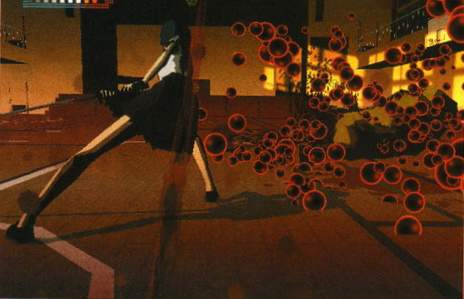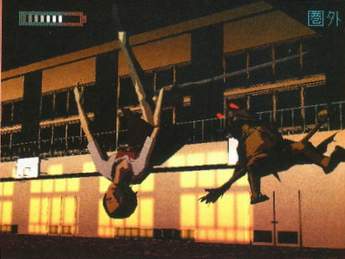Blood+ One Night Kiss
Slightly anaemic smacker.
One Night Kiss comes from the same (slightly bonkers but apparently occasionally genius) brain behind Capcom's Killer 7. Indeed if it hadn't been for the involvement of Grasshopper Manufacture's genuinely zany Goichi Suda, we could all safely assume that the game would only boast the limited appeal of yet another anime spin-off, and there'd be no need for a review. But after bravely taking on the boring orthodoxy of mainstream videogame design with Capcom's nonconformist classic, Suda's stock is high and first impressions of Blood+ are that it's another barnstorming confrontation with the consensus.
Like the anime series upon which it's based, (which is itself a spin-off from the highly-acclaimed movie Blood: The Last Vampire, fact-fans), the game's lead protagonist is a schoolgirl called Saya, who happens to be some sort of vampire/human hybrid with a calling in life to dispatch the Chiroptera - a vampire-like race of bat-men who go about their daily business disguised as humans. The game also features a supporting cast drawn from the series, and introduces another playable character in the shape of the extraordinarily coiffured, shotgun-wielding Aoyama, with the action switching between the two characters at preordained points within the game.
Although the game doesn't technically utilise the Killer 7 engine, it does feature a correspondingly outlandish artistic vision, so it's similarly super-stylish and slightly inexplicable. Unlike Killer 7, characters don't move on rails, and are free to explore their surroundings, but like Killer 7, the game world is superbly cel-shaded - full of fascinating angles, bold blocks of colour, and intriguing spaces. Every facet of the game, from load screens to in-game menus, has been rendered with sassy verve, and the opening cut-scenes prepare the tastebuds for another bout of Killer 7-style brilliance.

Sadly, the impetus of the opening sequence quickly peters out as soon as the action starts because the action initially consists of a pretty boring press-circle-to-talk-to-everyone -press-circle-to-interact-with-everything tutorial. It then meanders its way into a combat tutorial that is similarly disjointed - which makes it much easier to understand the decision to commence Killer 7 without any attempt to explain what was going on.
As to what's going on in One Night Kiss, it's actually pretty difficult to tell even with the tutorial, because the combat system bears an odd resemblance to some sort of rhythm-action collection of button presses and timings. An auto-aiming system makes it easy to slash enemies with Saya's big sword by battering the square button. Repeatedly doing so gradually builds up her blood meter until she enters a sort of berserk mode that allows her to deal actual damage - again, by hammering the square button. And after dealing enough damage, pressing triangle at the right time allows Saya to dispatch her opponents by following an on-screen button sequence. Blocks and counterattacks are handled by pressing the right button in time with icons that flash up on screen.
If that's boring to read, it's just as boring to play through - probably more so owing to the fact that each part of the process is book-ended (or interrupted) by cut-scenes - showing Saya getting her weapon out, showing Saya going berserk, showing Saya about to dispatch a vanquished foe, showing Saya having dispatched her vanquished foe etc. - that vary little over the course of the game. And any hope that things will resume Killer 7 levels of insane action after the tutorial has finished quickly prove excessively optimistic. In actual fact, this stop-start rhythm runs throughout the game, with long and largely uneventful cut-scenes acting as a coda to press-circle-on-everything-with-an-interactive-icon-while-wandering-aimlessly adventure sections, and oddly dysfunctional combat encounters that are few and far between, and far too easy.

Which is a shame, because here is clearly an attempt to devise an original game mechanic that captures the essence of the anime and the satisfaction of sashaying around with a sword. It's just that it fails to do either, and the inevitable sense of disappointment that ensues is compounded by a whole host of other classic design errors and annoyances: characters are obscured by walls during combat, making it impossible to avoid enemy attacks; enemy patterns often require a trial and error approach to overcome; large parts of the game world serve no in-game function and end up as redundant spaces; and the icons that denote interactive elements can sometimes be difficult to spot (as, for example, while looking for a floppy disk in a police station).
So in the end, all you're left with are some incredibly pretty graphics, a superb sense of style, some half-decent music, and one of the best phone vibration sounds in a videogame (hint: it's not your phone that's buzzing; it's hers). But that's not really enough to sustain any long-term interest or enjoyment, and it's especially underwhelming as a follow-up to one of the most waywardly creative games of the past few years. So while One Night Kiss is a decent reminder of Goichi Suda's restless creative spirit, it's also a reminder that he's slightly bonkers but only occasionally a bona fide genius.
